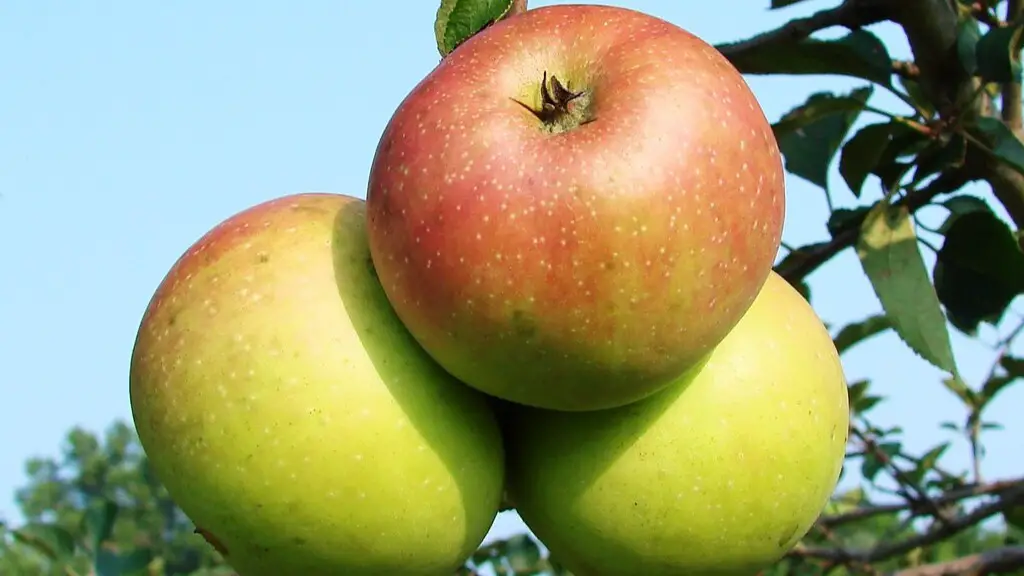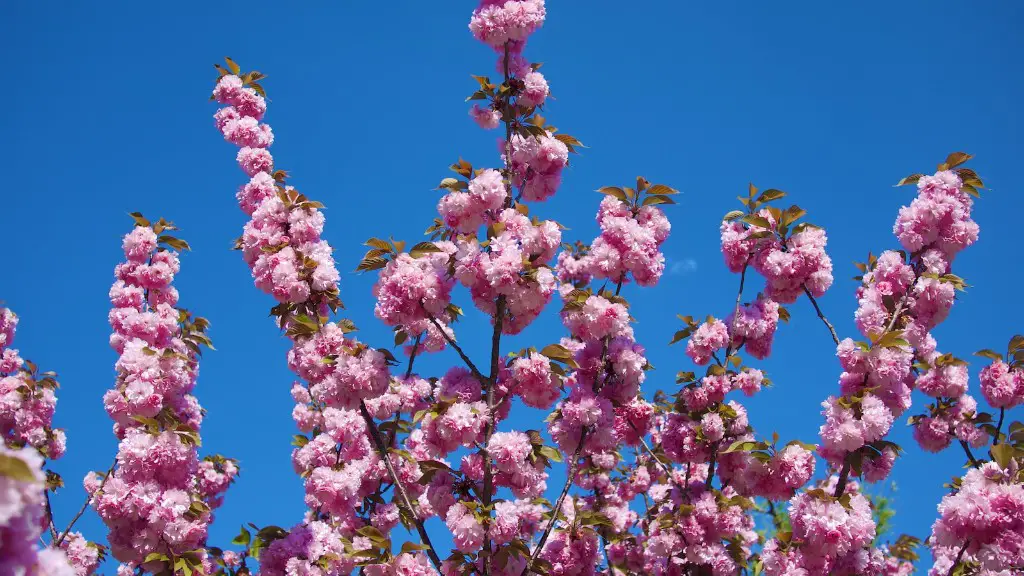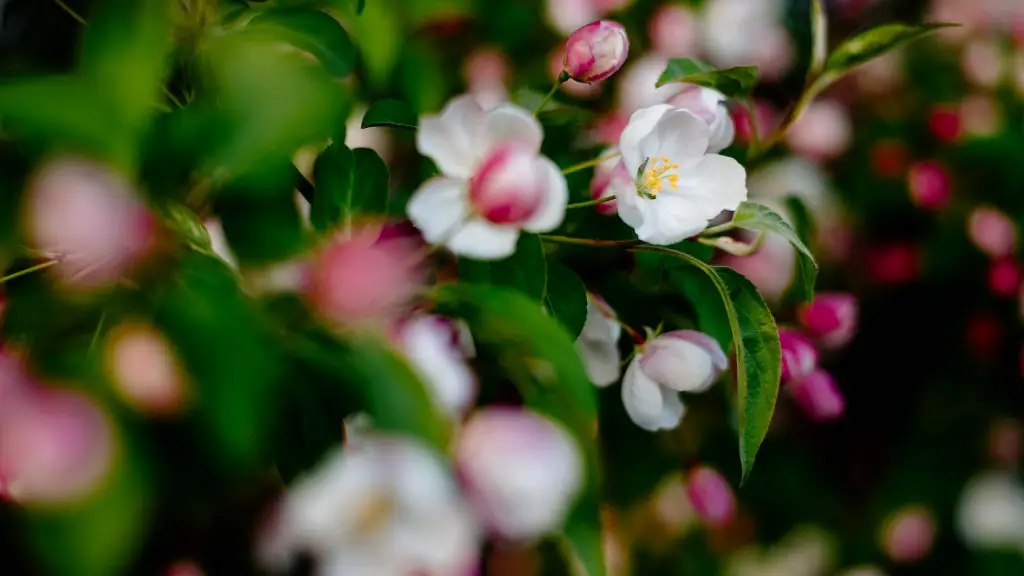Eating apples from a tree is not a behavior only seen in humans. Many animals, from birds to large mammals, actively search for ripe fruit trees to feed on their succulent treats. Apples, in particular, make for an especially appealing snack for numerous species of wildlife. But what particular animals tend to feast on apples from a tree?
One common apple thief is the white-tailed deer. This species of deer enjoys browsing apple trees, consuming both the leaves and the sweet fruits. When deer graze on an apple tree, they will also commonly chomp on leaves and twigs, which can lead to significant damage to the tree. Deer, however, do not only eat apples off the tree. They are also attracted to the dropped apples on the ground, which they can normally find quite easily.
The iconic American black bear is sometimes known to feast in apple trees. Bears will climb and pick apples off the tree, but they will also search the ground below for apples. Furthermore, they can cause more destruction than deer as they can sometimes rip down small trees in their search for ripe fruits. Bears often wait until apple trees are full of ripe fruit before coming around for a meal.
The omnivorous raccoon is also known for foraging for apples in the wild. Raccoons will sometimes raid apple trees overnight, consuming both fruits and the smaller twigs from the branches. The highly-adaptive raccoon is not limited in where they can find their meal either, as they can search both standing trees and fallen fruits on the ground. Raccoons have even been known to hunt for apples in residential orchards when the opportunity presents itself.
Rabbits are another species with a fondness for apples. Domestic and wild rabbits alike will regularly feed on fallen apples from the ground and offer almost zero damage to the trees. Rabbits, on the other hand, will eat more than just the core of the apple; they tend to also consume the peels as well. Unlike some of the other animals mentioned, rabbits will pick their apples up in their mouths, as opposed to pawing it off from the tree.
In conclusion, many animals love to search for apples in the wild. Although the white-tailed deer, black bear, raccoon, and rabbit are the four most common animals for foraging apples, other, smaller creatures like foxes, mice, chipmunks, and turkeys will also snack on both the fruits and the foliage of apple trees.
Common Apple-Theft Methods of White-Tailed Deer
White-tailed deer are often the most common type of creature found attaining their food source from apple trees. Such animals will use a variety of methods to feast on the tree’s tasty treats. Ranging from leaves and unripe fruits to picking apple off the trees, deer will always make sure they get the most out of their visit to the tree. For instance, deer may browse at the foliage of the apple tree, eating the leaves as they go. They may also nibble on unripe apples, as its tart taste tends to be quite appealing to them.
However, the main way deer eat apples from a tree is by taking the whole fruit off the branches. This is not a behavior seen in most other animals, as many of them will either stay at the ground level or only remove smaller pieces. Deer, on the other hand, are well known for plucking the ripe apples from their branches and snacking away. Due to their tall height, they can reach fruits much higher up than any other creature, gaining access to many more apples to avail.
By applying their tongue, deer can grab the apple off its branch and quickly move it towards its mouth. With both their dexterity and long tongue, they have no issue picking off the fruit one by one. They will often continue to search the tree, trying their luck at finding any other fruits they could munch on. And this continues until they are satisfied with the selection they’ve had or there are no other apples left in the tree.
Lastly, some deer may be bold enough to climb-up the tree, if necessary. Although this is not a common behavior and occurs very rarely, it still happens from time to time. Deer are surprisingly good climbers and can reach many different heights but as previously mentioned, this is not a usual case. Some deer may even attempt to climb-up the tree’s bulkier branches, making it close to impossible for them to succeed.
Apple theft detection
The animals’ common behavior of stealing apples from the tree has made many landowners uneasy, as this poses numerous risks to the apple trees in their orchards. To take matters into their own hands, some orchard owners have implemented various methods to protect their trees from theft. Different plans have been set into motion, all of which attempt to dissuade animals from getting too close to the trees.
In some cases, landowners have opted to install fencing around the perimeter of their orchard. This can be made out of an array of materials, such as wood, plastic, netting, or even metal wire. Doing so prevents any deer or other uninvited guests from entering the area and keeps any fruits within the bounds of the fence. Such a method, nevertheless, has its own drawbacks, as it requires more money and effort for proper installation.
Other options include setting up a motion-activated sprinkler or ultrasonic bird repellent device to scare away approaching animals. Artificial birds of prey can also be used, as some deer might mistake them for a real one and run away in fear. In some cases, a landowner may use a combination of different techniques to protect their trees from theft.
In order to prevent apple rot, some landowners also pick the apples before they reach their maximum ripeness. Doing so will ensure that deer, bears, or any other animals cannot access the fruits at such a stage. Furthermore, this allows the fruit to gain its maximum sweetness before consumed. In the same vein, orchard owners often harvest the apples when they reach their peak of ripeness, so that animals do not get the chance to choose the best apples for themselves.
However, the most important step any landowner can take towards protecting their apple trees from theft is to set up motion activated lights. The lights will serve as a warning system to any approaching animal, alerting them to their presence and ultimately scaring them away. Such a measure is relatively cheap and is proven to be an extremely effective strategy to protect orchards from theft.
What Role Do Apple Trees Play in Wildlife’s Natural Diet?
Apple trees play an essential role in many species’ diet, even if humans are not aware of it. Such trees can provide both sustenance and long-term protection against many predators. Species like the white-tailed deer, black bear, raccoon, rabbit, foxes, and many birds nourish themselves from the ripe fruits of the trees. These animals use the apples to provide them the sugar, carbohydrates, and fat content found in the fruits.
In areas containing apple trees, larger herds of species like deer, bear, and rodents tend to form. This is because the plentiful harvest from the apple trees offers them an excellent source of nourishment. Animals like these feed on the fruits, leaves, and twigs all year round, providing them with a plentiful diet for the entire season. By forming larger herds, they can also protect themselves from any potential predators.
Apple trees also provide nesting places for numerous species of birds. The wider, sturdier branches of apple trees make for excellent building grounds that provide both shelter and insulation. Certain birds prefer apple trees to build nests due to their large amount of nectar, which the birds can feed on when the fruit buds are blooming. By staying around the same tree, birds can gain access to a consistent and reliable food source.
In the winter months, apple trees are essential to species like the red deer and white-tailed deer as it allows them to keep nourished and energized on core temperature-resistant food. Such nourishment boosts their survival rates against extreme cold weather, allowing them to maintain their natural defenses and survive longer.
Apple trees, overall, provide a safe haven and reliable source of nutrition for many species throughout the year. Regardless of season, different species can benefit from the apples’ versatility, nourishing themselves from the tree’s fruits, leaves, and flowers. In areas where apple trees are found, a more diverse species of wildlife can also be found, making for a more vibrant and flourishing environment.
Sustainable Apple Harvesting
With wildlife heavily relying on orchards for nourishment, it is essential that landowners take a more compassionate approach towards apple harvesting. Sustainable apple harvesting is the practice of farmers aiming to prevent any animal disturbance while still gathering the apples they need. Some farmers decide to perform their harvest late at night, when animals are dormant and have retired back to their dens, offering a less disruptive experience.
In some cases, apple farmers may decide to withhold their harvest until the animals have gradually dispersed or moved to other orchards. While this may extend the expected duration of harvest, it is often a more humane approach that prevents any unnecessary animal stress or disturbance. Other farmers opt for more innovative methods like luring the animals away with food and other treats whilst they are harvesting.
Wildlife friendly harvesting is slowly becoming the preferred approach for many orchard owners. Such a method seeks to minimize any disruptions to the surrounding environment and creature species, making for a less destructive harvesting experience. In many cases, fruits are also hand-picked throughout the procedure as well, as this is seen to allow for a more gentle plucking and collecting session.
By instituting such techniques, orchard owners have noticed a commensurate reduction in animal disturbances. Some have even reported witnessing less animal interactions and a greater amount of animals realizing they are in no immediate danger. Such changes in behavior lead to less damage to orchards and a more fruitful harvest. As such, sustainable apple harvesting is becoming the go-to practice for many orchard owners nationwide.
Apple Orchard Dispersal & Regeneration
The protection of apple orchards is extremely important, as they offer a vast source of food and protection to numerous species of wildlife. The regeneration and planting of new apple trees play an essential role in maintaining this food source, promoting more wildlife in the process. To maximize the potential of the apple tree, scattered planting is commonly recommended for many orchards.
Scattered planting refers to the use of natural regeneration, by allowing windblown fruits to spread and grow in the orchard. On its own, such a method can generate diverse eco-systems on the orchard, as many different species of animals will come to benefit from the multiple food sources available. This is due to the unsystematic patterns in which the fruits are spread, creating multiple surfaces and obstacles that many different animals can thrive in.
Other methods such as manual scattering can also be done to widen the plants’ dispersal. This includes planting small seedlings on the ground outside of the reach of predators. This tactic allows for an abundance of unique species to populate the surrounding area, overall proliferating the apples and their benefits for the wildlife.
Even the removal of extra vegetation can play a major role in regenerating an orchard. By pruning some trees, a greater amount of sunlight will reach the lower lying branches, allowing for larger and stronger apples to grow. Some experts have even suggested thinning out the trees in one orchard as a way of controlling heavy deer populations. By having fewer standing trees, the pasture area will expand and herd sizes will gradually drop.
All in all, orchard regeneration is a delicate process. By having a better understanding of apple trees and their value, landowners can ensure that these wonders of nature continue to persist and their wildlife inhabitants thrive. With the combination of variations in regeneration approaches, orchard owners can create the most conducive environment for their apple trees and their wildlife.





